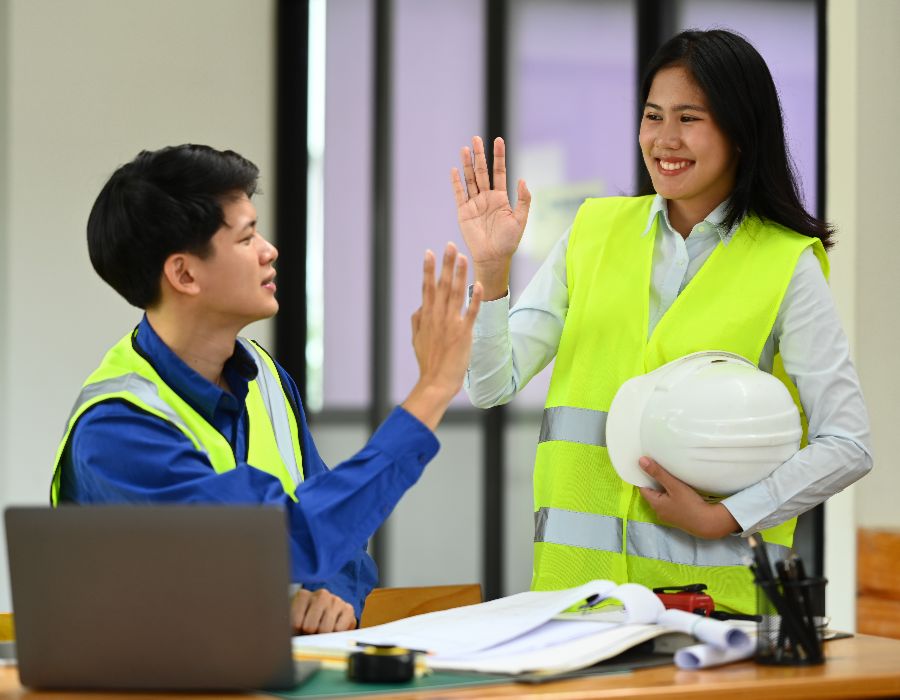Table of Contents
Related Articles
Construction Safety In Occupied Buildings: Protecting Staff During Renovations

Managing construction projects while maintaining normal educational operations creates one of the most complex safety challenges facing Massachusetts independent schools and cultural institutions. Unlike typical construction sites where the primary concern involves protecting construction workers, occupied building projects require simultaneous protection of regular staff, students, visitors, and construction crews who must share the same physical space.
The fundamental challenge lies in managing two entirely different safety cultures within the same building. Educational staff follow established routines focused on teaching and daily operations, while construction workers operate according to industrial safety protocols. When these groups intersect without proper planning and communication, accidents become highly probable and costly.
The stakes extend far beyond immediate safety concerns. Poor construction safety management can result in serious injuries, significant workers compensation claims, operational disruptions affecting educational programs, regulatory violations, and liability exposures that impact institutions for years. Conversely, well-managed projects demonstrate institutional competence while protecting everyone involved.
Understanding The Unique Hazards
Occupied building construction creates hazard profiles that don’t exist in either typical construction sites or normal educational environments. These unique risks emerge from the intersection of construction activities with ongoing institutional operations, creating situations where standard safety approaches may be inadequate.
Dust and airborne contaminants represent the most pervasive concern because construction activities generate particles that affect air quality throughout buildings, not just in immediate work areas. Renovation projects often disturb asbestos, lead paint, or other hazardous materials that pose serious health risks. Unlike construction sites where workers expect exposure and use protection, educational staff may be unaware of risks or lack proper protective equipment.
Noise levels during construction can exceed safe exposure limits for regular building occupants who lack hearing protection. Physical hazards multiply when construction areas aren’t properly isolated from occupied spaces. Open excavations, exposed electrical systems, and construction equipment create immediate dangers for anyone who inadvertently enters work areas.
Chemical exposures from adhesives, paints, and solvents can affect building occupants far from work areas if ventilation systems distribute contaminated air throughout buildings. Construction workers receive training about chemical hazards and use protective equipment, while educational staff may be exposed without understanding risks or having access to protection.
Essential Planning & Coordination Requirements
Successful occupied building construction requires comprehensive planning that addresses the needs and safety of all building occupants, not just construction crews. This planning must begin months before construction starts and continue throughout project duration with regular adjustments.
The foundation involves detailed hazard assessments that consider how construction activities will affect different building areas and various categories of occupants. These assessments must go beyond typical construction safety evaluations to include impacts on educational programming, emergency procedures, indoor air quality, noise levels, and accessibility requirements.
Critical Planning Elements:
- Comprehensive hazard assessments addressing construction and occupancy interactions
- Work scheduling that minimizes disruption to educational operations
- Zone isolation with physical barriers between construction areas and occupied spaces
- Emergency response procedures adapted for construction-related incidents
- Communication protocols between construction crews, administrators, and educational staff
- Air quality monitoring and ventilation management throughout construction periods
Work scheduling becomes particularly complex in educational environments because construction must accommodate class schedules, special events, and seasonal building usage variations. Summer construction windows offer advantages, but many projects require year-round work demanding careful coordination with educational calendars.
Zone isolation requires creating physical barriers between construction areas and occupied spaces while maintaining emergency egress routes and accessibility requirements. Temporary walls, plastic sheeting, and air filtration systems help contain construction hazards, but effectiveness depends on proper installation and ongoing maintenance.
Managing Air Quality & Environmental Hazards
Indoor air quality management becomes critical during occupied building construction because contaminated air can affect building occupants throughout facilities. Construction activities generate airborne contaminants including dust from cutting operations, vapors from adhesives and paints, and particles from demolition work.
Ventilation system management requires balancing containment of construction-related contaminants with maintaining acceptable indoor air quality for regular building occupants. This often involves installing temporary ventilation systems, modifying existing HVAC operations, and creating negative pressure relationships that prevent contaminated air from spreading to occupied areas.
Air quality monitoring should include regular testing for dust levels, chemical vapors, and other contaminants that could affect building occupants. This monitoring must be conducted by qualified professionals using appropriate equipment that provides reliable data about potential exposure risks.
Special considerations apply when renovation projects involve asbestos, lead paint, or other regulated substances. These projects require specialized containment procedures, worker training, and disposal methods that exceed typical renovation practices. When buildings remain occupied, additional precautions become necessary to prevent exposure of regular building occupants.
Communication & Training Protocols
Effective communication represents the cornerstone of safe occupied building construction because it ensures everyone understands their roles, responsibilities, and potential hazards. Unlike typical construction projects where all workers share similar backgrounds, occupied building projects involve diverse groups with different safety knowledge and experience levels.
Pre-construction communication should include comprehensive briefings for all educational staff who will work in or near construction areas. These briefings must cover specific project hazards, restricted areas, emergency procedures that differ from normal protocols, and reporting procedures for safety concerns.
Construction crews require specialized training about working in occupied educational buildings. This training should address the presence of individuals who may not understand construction hazards, enhanced communication needs about dangerous activities, and specific procedures for preventing unauthorized access to construction areas.
Essential Communication Components:
- Pre-construction safety briefings for all affected educational staff
- Daily construction activity notifications highlighting potential hazards or disruptions
- Clear signage identifying construction zones, restricted areas, and alternative routes
- Regular safety meetings between construction managers and institutional administrators
- Incident reporting procedures addressing both construction and occupancy-related issues
Ongoing communication throughout projects should include daily notifications about hazardous activities, schedule changes affecting building occupants, and updates about air quality or environmental conditions that could impact health and safety.
Emergency Preparedness & Response Planning
Construction activities significantly complicate emergency preparedness because they can interfere with normal evacuation routes, disable safety systems, and create new emergency situations requiring specialized response procedures. Comprehensive emergency plans must consider scenarios that wouldn’t occur during either normal operations or typical construction projects.
Modified evacuation procedures may be necessary when construction activities block normal egress routes or when equipment and materials create evacuation obstacles. Alternative routes must be identified, clearly marked, and regularly inspected to ensure they remain viable throughout construction periods.
Fire protection systems may be temporarily disabled during construction, requiring alternative fire protection measures and enhanced fire watch procedures. Construction-related emergencies can include structural issues, chemical spills, and equipment accidents requiring immediate response from both construction crews and institutional personnel.
Emergency response plans must address coordination between construction emergency procedures and institutional emergency protocols to ensure effective response without confusion about roles and responsibilities. Communication systems used during emergencies may be affected by construction, requiring backup communication methods and alternative notification procedures.
Cost Control & Workers Compensation Considerations
Occupied building construction projects create complex workers compensation exposures because they involve both construction workers and regular institutional employees who may be affected by construction activities. Construction-related injuries can affect regular building occupants who encounter construction hazards, resulting in workers compensation claims against the institution even when contractors perform the actual construction work.
Contractor insurance coordination becomes critical for managing potential claims and ensuring appropriate coverage exists for all possible injury scenarios. This coordination should address not only construction worker injuries but also potential injuries to institutional employees that could result from construction activities.
Documentation requirements become more complex during occupied building construction because incidents could involve multiple parties with different insurance relationships. Proper documentation helps ensure appropriate claim handling while protecting institutional interests.
Cost control strategies should emphasize proactive safety measures that prevent incidents rather than simply responding to injuries after they occur. The cost of comprehensive safety planning and implementation typically represents a fraction of the cost associated with injuries and claims resulting from inadequate safety management.
Building Sustainable Safety Programs
Creating effective occupied building construction safety programs requires institutional commitment that integrates construction safety planning with broader operational and risk management systems. Success depends on understanding that protecting all building occupants during renovation projects requires specialized planning that goes beyond typical construction safety measures.
Sustainable Safety Program Elements:
- Leadership commitment demonstrated through adequate resource allocation and clear safety priorities
- Integration of construction safety planning with existing operational and risk management systems
- Regular program evaluation and continuous improvement based on project outcomes and lessons learned
- Staff training programs addressing both construction hazards and institutional safety protocols
- Vendor management ensuring contractors understand and comply with institutional safety requirements
Leadership commitment must be demonstrated through adequate resource allocation for safety planning, clear communication about safety priorities, and consistent support for safety measures even when they create operational inconveniences. When administrators actively support comprehensive safety planning, projects typically achieve better outcomes with fewer incidents.
ISCC members who implement thoughtful occupied building construction safety programs typically experience measurable improvements in both project outcomes and workers compensation results. These programs represent investments in institutional safety culture that pay dividends through reduced incidents, improved operational continuity, and successful project completion.
Contact ISCC today to discuss how our specialized expertise in educational and cultural institution safety can help your organization develop comprehensive safety programs for construction projects in occupied buildings, ensuring protection for all building occupants while managing workers compensation exposures effectively.




